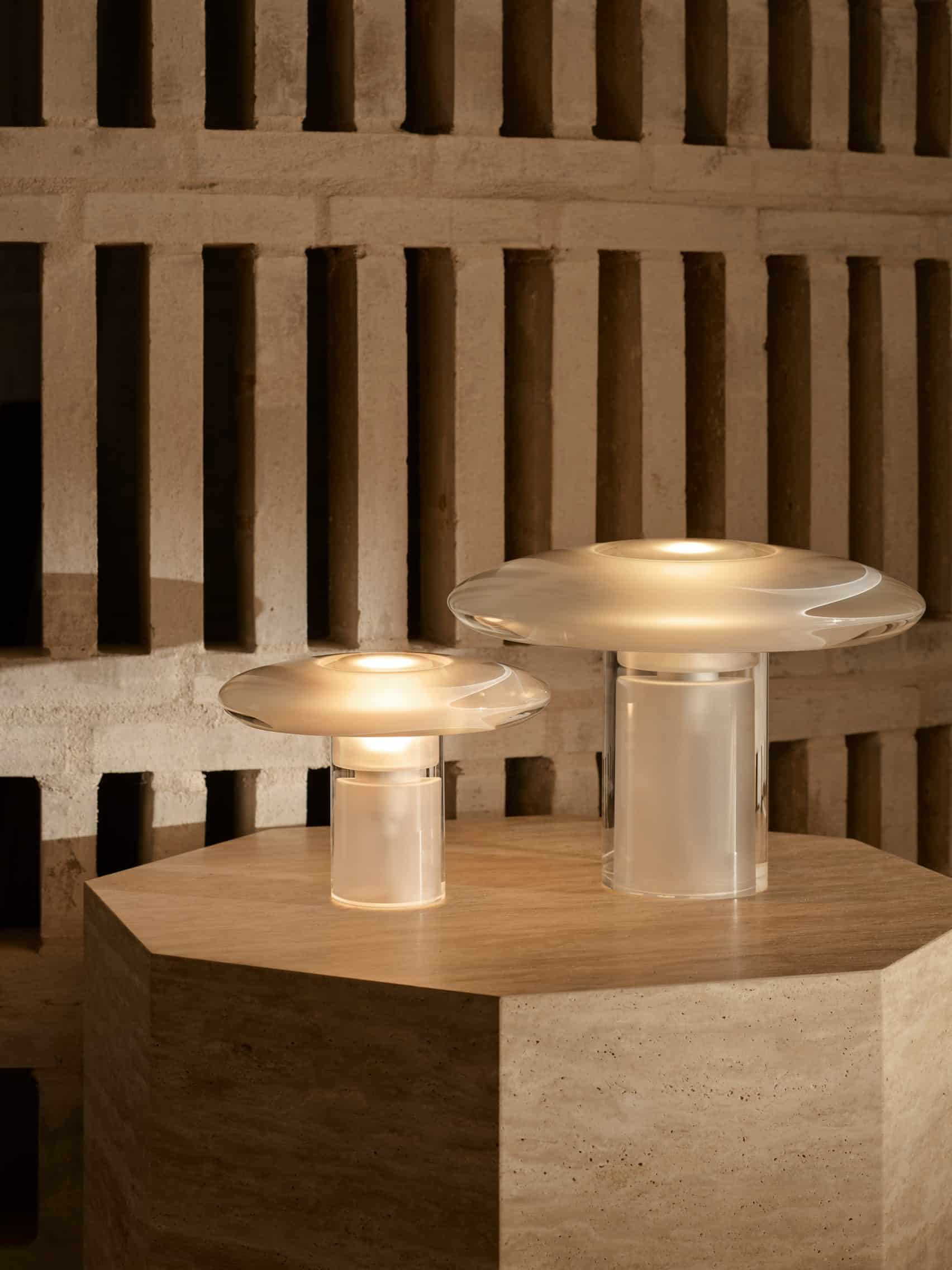Australian designer Tom Fereday has once again blurred the lines between functional object and sculptural form with the creation of the Nola Lamp for design brand Nau. Using hand-cast crystal glass and carved solid stone, Fereday has designed a lighting piece that exudes tranquility, timelessness, and refined materiality.
While table lamps are often treated as accessories, the Nola Lamp elevates lighting to a statement of permanence — a poetic object that softly glows rather than simply illuminates. This is more than a design piece; it’s a material meditation on stillness, serenity, and sensual tactility.
Harmonious Form: Where Light Meets Sculpture
At first glance, the Nola Lamp appears as a quiet, unassuming object. But its strength lies in this simplicity. The design is composed of only two elements: a cylindrical base and a lightly domed top, seamlessly joined to form a monolithic presence. There are no visible fasteners, no excessive detailing — just smooth, continuous form.
Fereday, known for his honest approach to material and function, emphasizes the sculptural purity of the piece. The lamp doesn’t rely on adornment; rather, it lets the inherent qualities of its materials — light transmission, grain, translucency — speak for themselves.
Material Poetry: Crystal and Stone
There are two material iterations of the Nola Lamp, each offering a distinct experience:
- Hand-cast crystal glass, which reveals the internal architecture of the lamp when lit. This version creates a mysterious inner glow, as if the light is suspended within a frozen moment.
- White jade stone, which filters the light more diffusely, providing a warmer and softer ambient effect. The natural veining of the stone makes each piece subtly unique.
By choosing materials known for their longevity and tactile allure, Fereday positions the Nola Lamp as a durable object — not trend-driven, but one meant to last both physically and aesthetically.
Lighting as a Spatial Gesture
When switched on, the Nola Lamp produces a low, warm-toned illumination that gently washes the surfaces around it. Rather than acting as a task light or focal spotlight, it contributes to the mood of a room. It offers what Nau describes as “a quiet glow and calming presence.”
This serenity makes the lamp highly versatile in interiors: it can serve as a side table accent, a bedside companion, or even stand alone on a pedestal as a sculptural object. The warm light accentuates the softness of its edges, enhancing its meditative aura.
In effect, the Nola Lamp behaves more like a design artifact than a typical product — more akin to a stone sculpture that happens to emit light.
Architectural Context: Light and Material in Space
From an architectural standpoint, the Nola Lamp belongs to a lineage of lighting that interacts closely with space. Its monolithic geometry and robust massing allow it to anchor a room, while its soft luminosity enables it to dissolve into ambient environments.
The transition from opaque to translucent, from mass to light, is architectural in its very nature. It mirrors how buildings often shift from structural solidity to glazed openness. In a similar way, the Nola Lamp holds mass at the base and releases light at the top — a metaphor for balance and lightness emerging from weight.
In minimalist or brutalist interiors, the Nola Lamp can act as a counterpoint to raw materials like concrete or steel. In more organic spaces, its softness and tactile warmth blend harmoniously.
Human Experience and Emotional Design
There is a deeply emotional undercurrent to the Nola Lamp’s design language. Its form invites touch, and its glow invites stillness. In a world overwhelmed by digital speed and artificial stimuli, this lamp offers a moment of pause — a visual and sensory relief.
As Fereday puts it indirectly through the design, not every object must shout to be heard. The Nola Lamp speaks in whispers, but with clarity.
Sizes, Use Cases, and Flexibility
The lamp is available in two sizes, making it suitable for a variety of environments and spatial needs. Whether as a pair on a console table or a single feature on a low shelf, its sculptural presence remains intact.
Moreover, the crystal version offers an extra dimension — its internal structure becomes visible when lit, adding a level of depth and complexity not seen in typical lighting designs. This makes it not just functional but contemplative — an object to be examined, not just used.
Description for Visual Context
Imagine a smooth cylindrical base of semi-translucent stone, perfectly carved, cool to the touch, tapering upward into a gentle dome. When unlit, it appears like a monolithic sculpture — almost ceremonial. When lit, it glows from within, its surface catching shadows and textures softly.
In crystal glass form, the lamp becomes even more evocative. Light shimmers within its volume like captured water or mist. Fine bubbles and textural variations in the glass add nuance, making each lamp subtly distinct.
Critical Perspective
The Nola Lamp succeeds on many levels: materially, functionally, aesthetically. However, its success also reveals a broader question: where does the boundary lie between art object and industrial design? As a limited-production, high-end piece, it’s not accessible to everyone. That exclusivity might limit its impact in democratizing good design.
Moreover, the focus on visual serenity risks falling into a trap of aesthetic minimalism without addressing environmental concerns. Are these materials sustainably sourced? Could there be a version that reuses post-industrial glass or stone remnants?
Until such questions are fully addressed, the Nola Lamp remains a beautiful, contemplative object — but one that still resides in the luxury design landscape, not the everyday.
For anyone looking for a reliable and up-to-date architectural resource, ArchUp offers fresh content covering projects, design, and competitions.
More on ArchUp:







